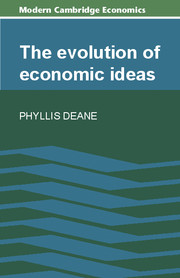Book contents
- Frontmatter
- Series preface
- Contents
- Introduction
- 1 Origins of modern economics
- 2 Adam Smith's theory of value
- 3 Origins of modern growth theory
- 4 Classical monetary theory
- 5 Ricardo on value, distribution and growth
- 6 Scope and methodology of classical political economy
- 7 The marginal revolution and the neo-classical triumph
- 8 The neo-classical theory of value
- 9 The Marxian alternative
- 10 Neo-classical orthodoxy in the inter-war period
- 11 Monetary theory in the neo-classical era
- 12 The Keynesian revolution
- 13 Twentieth-century growth theory
- 14 Methodological divisions in economics since Keynes
- Index of names
- Subject index
14 - Methodological divisions in economics since Keynes
Published online by Cambridge University Press: 05 June 2012
- Frontmatter
- Series preface
- Contents
- Introduction
- 1 Origins of modern economics
- 2 Adam Smith's theory of value
- 3 Origins of modern growth theory
- 4 Classical monetary theory
- 5 Ricardo on value, distribution and growth
- 6 Scope and methodology of classical political economy
- 7 The marginal revolution and the neo-classical triumph
- 8 The neo-classical theory of value
- 9 The Marxian alternative
- 10 Neo-classical orthodoxy in the inter-war period
- 11 Monetary theory in the neo-classical era
- 12 The Keynesian revolution
- 13 Twentieth-century growth theory
- 14 Methodological divisions in economics since Keynes
- Index of names
- Subject index
Summary
Use of the term Keynesian Revolution to characterise the impact of Keynes' General Theory on the evolution of economic ideas follows a convention approved by Keynes and his contemporaries and rendered commonplace by subsequent usage. There is a similar textbook tradition justifying the use of the term Marginal Revolution to denote the change-over as between the two systems of economic analysis – classical and neo-classical – which were sufficiently different in their leading questions, assumptions and techniques of analysis to imply an intellectual shift of revolutionary proportions. It may be unhelpful to stretch the Kuhnian analogy of a scientific revolution too far: but there is no doubt that the neo-classical system of thought which stemmed from the adoption of marginal techniques of analysis brought with it a radical and far-reaching change in the disciplinary framework and research priorities of the professional economist. The hallmark of the neo-classical economist is his formulation of the fundamental economic problem as primarily a question of optimal allocation of scarce resources, his mastery of marginal techniques of analysis designed to solve the problem of maximising output or utility, and a conceptual apparatus in which the assumption of long-term competitive equilibrium plays a crucial role. These are the professional attributes of any contemporary economist faced with a problem soluble at the microeconomic level as many of the current public policy problems certainly are.
- Type
- Chapter
- Information
- The Evolution of Economic Ideas , pp. 205 - 226Publisher: Cambridge University PressPrint publication year: 1978

